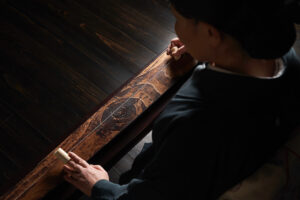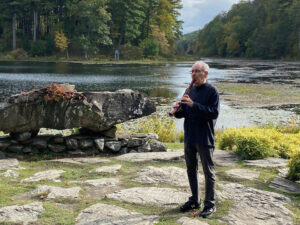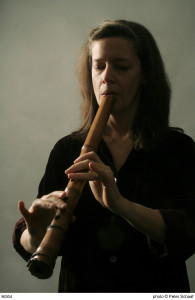Issui Minegishi, ichigenkin (1967-2023)
Ralph Samuelson, shakuhachi
Elizabeth Brown, shakuhachi
Trio Getsuro 月露 “dewdrops reflecting the light of the moon” brings together two traditional Japanese instruments that share an underlying aesthetic concept: the discovery of the world that lies within one note, one sound. The music and performance practice of our instruments are steeped in the aesthetic of Zen Buddhism. Ideally, the music is heard in a tranquil setting conducive to calm, focused listening. The ichigenkin’s philosophy of “one string” is a natural partner to the “one note” aesthetic of the shakuhachi. While the shakuhachi is becoming more familiar to audiences worldwide, opportunities to hear the ichigenkin are truly rare. Largely through the efforts of Issui Minegishi, the ichigenkin is gradually finding a new place in contemporary Japan and abroad. Our trio, with two musicians from America and one from Japan, presents numerous concerts in Japan and has toured in the US. Now we are honored to bring these beautiful instruments and their music to Innisfree.
The ichigenkin (one-string zither) is a horizontal zither composed of a single silk string set on a paulownia wood sounding board. Historical records indicate it may have appeared in Japan as early as the Heian period (c. 10th century). It then seems to have died out, but it subsequently reappeared in the 17th century. Because of its relationship to Chinese philosophy, it was played by priests, nobles, samurai, and literati. Ms. Minegishi is one of a small number of professional performers dedicated to carrying the instrument and its music into the 21st century.
The shakuhachi is a vertical bamboo flute with a notched mouthpiece and 5 finger-holes. It takes its name from the standard length of the instrument in traditional Japanese measuring units, 1 shaku 8 (hachi) sun. It first came to Japan from China in the 7th century and later developed to its present form during the 17th and 18th centuries, when it was played by a sect of Zen monks as a form of spiritual practice. The shakuhachi also performs traditional Japanese chamber music in ensemble with string instruments and voice, and its evocative sound has attracted the interest of contemporary composers, musicians, and audiences around the world.
In June 2022, Trio Getsuro had the privilege of performing in the magnificent setting of Innisfree Garden, a public nonprofit garden in Millbrook, New York. The natural beauty and quiet sounds of the garden melded so seamlessly with the tonal quality of our instruments that some audience members were brought to tears that summer day. The elegant rocks, plants, streams, and waterfalls of the garden are the inspiration for this recording. Innisfree Garden was initially established by artist Walter Beck and his wife Marion on their Millbrook property in the 1930s, inspired in part by Chinese landscape and garden paintings. The Becks further developed Innisfree in collaboration with Harvard University landscape architect Lester Collins, a scholar and translator of the seminal 11th-century Japanese gardening text, Sakuteiki. The magical garden they created appears to be of expansive majesty, yet within it one finds introspective vignettes that offer a concentrated focus on the beauty of nature and the human spirit, much like the music we play with ichigenkin and shakuhachi. We hope you enjoy this Music from Innisfree.
Read Laurence Carr’s review of the concert at Innisfree here.
“Went to a concert by Trio Getsuro. The trio featured Issui Minegishi on ichigenkin and Ralph Samuelson and Elizabeth Brown on shakuhachi.
The performance lived up to their words, “discovering the world within a single note.”
Every time I listen to these musicians, I am reminded of something important that I have forgotten.
A quiet world of sound.
A pleasant sensory experience.
I feel the urge to return to nature.
—Takafumi Tanaka, editor of Hougaku Journal
Trio Getsuro: Music at Innisfree
Album Liner Notes
Track 1 秋巡り来て Aki Meguri Kite “autumn comes round again” (2015) by Elizabeth Brown
Poetry from “Voices from Japan*, tanka written by survivors of the 2011 earthquake and tsunami, originally published in the Asahi Shinbun.
my home place has become a town without voices, without humans
it is as distant as the end of the earth
– Keiko Hangui, Fukushima May 2011
the souls of the dead
sheltering in the moon
descend to the lone pine in Rikuzen-takata
autumn comes round again
– Shoichi Hirai, Saitama October 2011
* Used with permission: Isao and Kyoko Tsujimoto, Studio for Cultural Exchange, Tokyo.
English translations by Joan Ericson, Amy Heinrich, and Laurel Rasplica Rodd.
Track 2 夜開花 Yakaika “night-blooming cereus” (1968)
Music and poem by Isshi Yamada; shakuhachi part added by Naoki Kooriyama
“In the purple dusk, a mysterious white flower is blooming on the hedge. It lives for only one night.
For whom is it waiting, in the silence of the night,
with the summer moon high in the sky?”
Tracks 3-5 純音 Jyun On “pure sound” (2016) by Robert Carl
1. Garden Walk
2. Night Cry
3. Moon Viewing
Jyun On is a musical meditation in three movements. It explores the focused, direct, and haunting sound of these instruments in conversation.
Robert Carl was chair of the composition program at the Hartt School, University of Hartford, and Slee Professor of Music at the University at Buffalo. In 2021 the Boston Modern Orchestra Project released a disc of four of his largescale compositions, and Bloomsbury Academic published his essay set Music Composition in the 21st Century: a Practical Guide for the New Common Practice. In August 2021 his opera Harmony (libretto by novelist Russell Banks) was premiered at the Seagle Festival in the Adirondacks.
Track 6 竹友 Take no Tomo “bamboo friend” Music by Kakuho (1729-1815)
Japanese free verse based a poem by Oi (701-761)
“With no connection to the sadness and suffering of the world, the mountain depths grow thick and luxuriant. Having come to live in this forest, I find my spirit growing straight as the bamboo, with my senses clear as the sparkling waters. I know this can hardly be understood by those of the workaday world. It is only the moon, shining all through the night, which understands my heart.”
Track 7 不二 Fuji “peerless Fuji” (1986) by Issui Matsuzaki (3rd Head of Seikyo-do Ichigenkin lineage)
Verse by Saigyo (1118-1190) added by Ichiyo Saito of Seikyo-do Ichigenkin
Shakuhachi part added by Akihito Obama
“with time, the smoke floating on the breeze becomes one with the sky over Mt.Fuji, and vanishes. Just as my thoughts which come and then fade into the unknown.”
Track 8 ひふみよいむなやこと Hi fu mi yo i mu na ya ko to “1,2,3,4,5,6,7,8,9,10” (2020) by Issui Minegishi
“In the old Japanese counting system, the notes of the ichigenkin are lined up from 1 to 10. Thus, the simple sounds of the ichigenkin are simply arranged. Please listen to it as the very beginning of things.”
Track 9 まほろしによせて Maboroshi ni Yosete “approaching a dream” (2021) by Shirotomo Aizawa
Based on the ichigenkin piece Maboroshi by Ichiyo Saito; text by Princess Naishinno Shikishi
“The things I have seen and the things I have not seen, in the haze that floats above my pillow.”
Composer Aizawa Shirotomo graduated from Tokyo National University of Fine Arts and Music and graduate school composition course with full national scholarship. He studied at Berlin and Vienna National Music School, and Hochschule in a conducting course. Ataka prize, composition prize from Japan national theater.
Track 10 下り葉の曲 Sagari Ha no Kyoku “falling leaves” traditional shakuhachi melody
Arranged by Goro Yamaguchi for shakuhachi duo
Ichigenkin part added by Elizabeth Brown
Performers
 Issui Minegishi 峯岸一水 (1967-2023) was the 4th Iemoto, or heir, of the Seikyo-do Ichigenkin Tradition. The Seikyo-do follows the idea of Zen practice, which removes all unnecessary vanities. She was trained by her great-grandmother, the 3rd heiress, an officially designated Intangible Cultural Trea- sure of Japan, and she has performed around the world. At her 2008 Kioi Hall concert in Tokyo, she was honored with the presence of Her Majesty the Empress of Japan, Michiko. Issui Minegishi won the bronze prize in the division “1-2 string musical instruments” at Delphic 2009 (The Art and Cultural Olympic Games) in Jeju, Korea. She received Asian Cultural Council grants in 2010 and in 2013. An active composer and improviser, Issui Minegishi has collaborated with numerous artists, dancers, and musicians. She recently completed an innovative recording project featuring ichigenkin compositions by each successive head of the Seikyo-do lineage as well as new works that she commissioned to expand the repertoire.
Issui Minegishi 峯岸一水 (1967-2023) was the 4th Iemoto, or heir, of the Seikyo-do Ichigenkin Tradition. The Seikyo-do follows the idea of Zen practice, which removes all unnecessary vanities. She was trained by her great-grandmother, the 3rd heiress, an officially designated Intangible Cultural Trea- sure of Japan, and she has performed around the world. At her 2008 Kioi Hall concert in Tokyo, she was honored with the presence of Her Majesty the Empress of Japan, Michiko. Issui Minegishi won the bronze prize in the division “1-2 string musical instruments” at Delphic 2009 (The Art and Cultural Olympic Games) in Jeju, Korea. She received Asian Cultural Council grants in 2010 and in 2013. An active composer and improviser, Issui Minegishi has collaborated with numerous artists, dancers, and musicians. She recently completed an innovative recording project featuring ichigenkin compositions by each successive head of the Seikyo-do lineage as well as new works that she commissioned to expand the repertoire.
 Ralph Samuelson is a shakuhachi performer and teacher and a pioneer in the growing presence of shakuhachi music in the US. He was trained in the classical tradition of the Kinko School of shakuhachi by the late Living National Treasure Goro Yamaguchi as well as by Shudo Yamato and Kodo Araki V, both in Japan and in the graduate world music program at Wesleyan University. He performs traditional and contemporary music around the world and has recorded for Innova, CBS Masterworks, Tzadik, and other labels. He was the shakuhachi soloist in the New York City Ballet production of Jerome Robbins’ “Watermill” with music by Teiji Ito, and his “Flutes of Hope” ensemble commemorating the victims of the 2011 earthquake/tsunami in Japan has been pre- sented annually in New York.
Ralph Samuelson is a shakuhachi performer and teacher and a pioneer in the growing presence of shakuhachi music in the US. He was trained in the classical tradition of the Kinko School of shakuhachi by the late Living National Treasure Goro Yamaguchi as well as by Shudo Yamato and Kodo Araki V, both in Japan and in the graduate world music program at Wesleyan University. He performs traditional and contemporary music around the world and has recorded for Innova, CBS Masterworks, Tzadik, and other labels. He was the shakuhachi soloist in the New York City Ballet production of Jerome Robbins’ “Watermill” with music by Teiji Ito, and his “Flutes of Hope” ensemble commemorating the victims of the 2011 earthquake/tsunami in Japan has been pre- sented annually in New York.
 Elizabeth Brown combines a composing career with a diverse performing life, playing flute, shakuhachi, and theremin. Her music is performed around the world and she is celebrated both here and in Japan for her many compositions combining Western and Japanese instruments and sensibilities. A Juilliard graduate and Guggenheim Fellowship recipient, Brown has received grants, awards and commissions from the Asian Cultural Council, Japan Foundation, Music from Japan, Orpheus, St. Luke’s Chamber Ensemble, Momenta Quartet, Sylvan Winds, Bridgehamp- ton Chamber Music Festival, NewMusicUSA, NYSCA, NYFA, and others. She studied shakuhachi with Ralph Samuelson, and with Shudo Yamato and Koumei Mizuno in Japan. Brown teaches shakuhachi at Columbia University and Bard College. “Elizabeth Brown: Mirage” is available from New World Records.
Elizabeth Brown combines a composing career with a diverse performing life, playing flute, shakuhachi, and theremin. Her music is performed around the world and she is celebrated both here and in Japan for her many compositions combining Western and Japanese instruments and sensibilities. A Juilliard graduate and Guggenheim Fellowship recipient, Brown has received grants, awards and commissions from the Asian Cultural Council, Japan Foundation, Music from Japan, Orpheus, St. Luke’s Chamber Ensemble, Momenta Quartet, Sylvan Winds, Bridgehamp- ton Chamber Music Festival, NewMusicUSA, NYSCA, NYFA, and others. She studied shakuhachi with Ralph Samuelson, and with Shudo Yamato and Koumei Mizuno in Japan. Brown teaches shakuhachi at Columbia University and Bard College. “Elizabeth Brown: Mirage” is available from New World Records.
Special thanks: Lea and Jim Cornell, Kate Kerin, and Laura Palmer of Innisfree Garden; Frances White; Lothar Osterburg; Andrea Samuelson
Tracks:
1-6 Elizabeth Brown, Aki Meguri Kite 1:57, 2:44, 3:05, 1:50, 3:49, 1:05
7 Isshi Yamada, Yakaika 6:24
8-10 Robert Carl, Jyun On 3:13, 3:11, 5:42
11 Kakuho, Take no Tomo 5:08
12 Issui Matsuzake, Fuji 5:19
13 Issui Minegishi, Hi Fu Mi Yo 5:52
14 Shorotomo Aizawa, Mabaroshi 5:10
15 traditional Sagari, Ha no Kyoku 5:45
Performers:
1-6, 8-10, 11, 15: Elizabeth Brown, Issui Minegishi and Ralph Samuelson
7,14: Issui Minegishi and Ralph Samuelson
12: Issui Minegishi and Elizabeth Brown
13: Issui Minegishi

